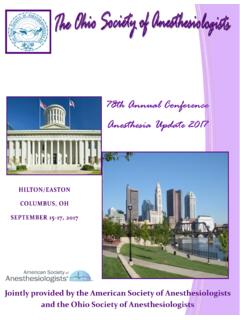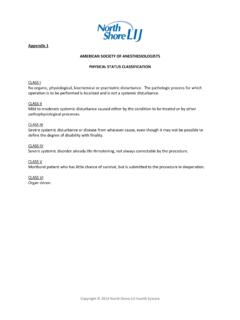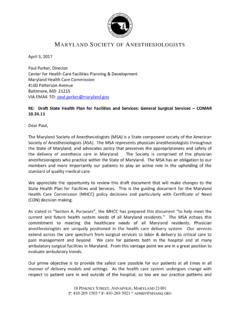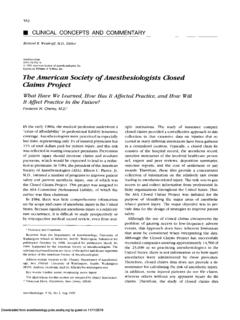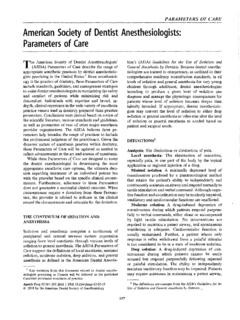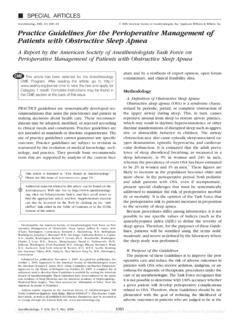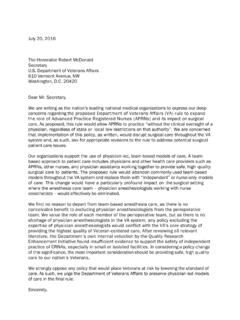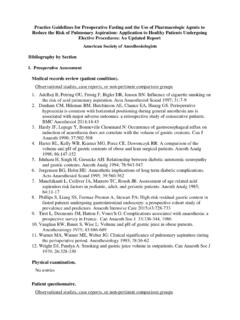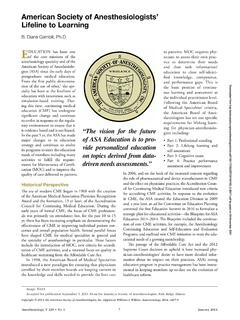Transcription of American Society of Dentist Anesthesiologists Parameters ...
1 Appendix 2 American Society of Dentist Anesthesiologists Parameters of Care 1 American Society of Dentist Anesthesiologists Parameters of Care APRIL 29, 2011 Introduction The American Society of Dentist Anesthesiologists (ASDA) Parameters of Care describe the range of appropriate anesthetic practices by Dentist Anesthesiologists for patients undergoing dental, oral, maxillofacial and adjunctive surgical procedures within the scope of dental practice. These Parameters of Care include standards, guidelines and management strategies in an effort to assist Dentist Anesthesiologists in maximizing the safety and comfort of their dental patients while minimizing risks and discomfort.
2 Individuals with expertise and broad, in-depth clinical experience in the wide variety of anesthesia practice venues and models used in dentistry prepared these practice Parameters . Their conclusions were derived on the basis of review of the scientific literature, various standards and guidelines, as well as Parameters of care of other major anesthesia provider organizations. The ASDA believes these Parameters help broaden the range of practices to include the professional judgment of the practitioner.
3 Given the dynamic nature of anesthesia practice within dentistry, these Parameters will be updated as needed to reflect advancements in the art and science of anesthesia. While these Parameters of Care are designed to assist the Dentist anesthesiologist in determining the most appropriate anesthetic care options, the ultimate decision regarding treatment of an individual patient lies with the provider, in light of the specific clinical circumstances. Furthermore, adherence to these Parameters does not guarantee a successful clinical outcome.
4 When circumstances require a deviation from these Parameters , the provider is advised to indicate the circumstances and rationale for the deviation in the clinical record. The ASDA strongly supports these Parameters of Care for practicing Dentist Anesthesiologists , while also supporting the right of other professional dental organizations to determine their own Parameters of care for the practice of sedation and general anesthesia utilizing their own educational guidelines within state licensure requirements to ensure the comfort and safety of their dental patients.
5 At the same time, the ASDA supports the American Dental Association s (ADA s) Guidelines for the Use of Sedation and General Anesthesia by dentists , and the associated Guidelines for Teaching Pain Control and Sedation to dentists and Dental Students, as minimum guidelines that should be followed by all dentists providing any form of sedation or general anesthesia. 2 The Continuum of Sedation and Anesthesia Sedation and anesthesia comprise a continuum of peripheral and central nervous system depression ranging from local anesthesia through various levels of sedation to general anesthesia.
6 The ASDA Parameters of Care support the definitions of local anesthesia, minimal sedation, moderate sedation, deep sedation and general anesthesia as defined in the ADA s Guidelines for the Use of Sedation and General Anesthesia by dentists . Because Dentist Anesthesiologists are trained to proficiency in all levels of sedation and general anesthesia for dentistry, Dentist Anesthesiologists intending to produce a given level of sedation are able to diagnose and manage the physiologic consequences (rescue)
7 For patients whose level of sedation becomes deeper than initially intended or, if appropriate, convert the level of sedation to either deep sedation or general anesthesia or otherwise alter the sedation or general anesthesia as needed based on patient and surgical needs. Definitions analgesia - the diminution or elimination of pain. local anesthesia - the elimination of sensation, especially pain, in one part of the body by the topical application or regional injection of a drug. minimal sedation - a minimally depressed level of consciousness produced by a pharmacological method that retains the patient's ability to independently and continuously maintain an airway and respond normally to tactile stimulation and verbal command.
8 Although cognitive function and coordination may be modestly impaired, ventilatory and cardiovascular functions are unaffected. moderate sedation - a drug-induced depression of consciousness during which patients respond purposefully to verbal commands, either alone or accompanied by light tactile stimulation. No interventions are required to maintain a patent airway, and spontaneous ventilation is adequate. Cardiovascular function is usually maintained. Further, a patient whose only response is reflex withdrawal from a painful stimulus is not considered to be in a state of moderate sedation.
9 Deep sedation - a drug-induced depression of consciousness during which patients cannot be easily aroused but respond purposefully following repeated or painful stimulation. The ability to independently maintain ventilatory function may be impaired. Patients may require assistance in maintaining a patent airway, and spontaneous ventilation may be inadequate. Cardiovascular function is usually maintained. general anesthesia - a drug-induced loss of consciousness during which patients are not arousable, even by painful stimulation. The ability to independently maintain ventilatory function is often impaired.
10 Patients often require assistance in maintaining a patent airway, and positive pressure ventilation may be required because of depressed spontaneous ventilation or drug-induced depression of neuromuscular function. Cardiovascular function may be impaired. The above definitions are excerpts from the ADA s Guidelines for the Use of Sedation and General Anesthesia by dentists 3standards - clinical practices that are to be applied in all cases. Deviation from standards would be difficult to justify.

